16 March 2020 Imperial College COVID-19 Response Team Introduction The COVID-19 pandemic is now a major global health threat. As of 16th March 2020, there have been 164,837 cases and 6,470 deaths confirmed worldwide. Global spread has been rapid, with 146 countries now having reported at least one case. The last time the world responded to a global emerging disease epidemic of the scale of the current COVID-19 pandemic with no access to vaccines was the 1918-19 H1N1 influenza pandemic. In that pandemic, some communities, notably in the United States (US), responded with a variety of non- pharmaceutical interventions (NPIs) - measures intended to reduce transmission by reducing contact 1 rates in the general population . Examples of the measures adopted during this time included closing schools, churches, bars and other social venues. Cities in which these interventions were implemented early in the epidemic were successful at reducing case numbers while the interventions remained in 1 place and experienced lower mortality overall . However, transmission rebounded once controls were lifted. Whilst our understanding of infectious diseases and their prevention is now very different compared to in 1918, most of the countries across the world face the same challenge today with COVID-19, a 2 virus with comparable lethality to H1N1 influenza in 1918. Two fundamental strategies are possible : (a) Suppression. Here the aim is to reduce the reproduction number (the average number of secondary cases each case generates), R, to below 1 and hence to reduce case numbers to low levels or (as for SARS or Ebola) eliminate human-to-human transmission. The main challenge of this approach is that NPIs (and drugs, if available) need to be maintained – at least intermittently - for as long as the virus is circulating in the human population, or until a vaccine becomes available. In the 3 case of COVID-19, it will be at least a 12-18 months before a vaccine is available . Furthermore, there is no guarantee that initial vaccines will have high efficacy. (b) Mitigation. Here the aim is to use NPIs (and vaccines or drugs, if available) not to interrupt transmission completely, but to reduce the health impact of an epidemic, akin to the strategy adopted by some US cities in 1918, and by the world more generally in the 1957, 1968 and 2009 influenza pandemics. In the 2009 pandemic, for instance, early supplies of vaccine were targeted at individuals 4 with pre-existing medical conditions which put them at risk of more severe disease . In this scenario, population immunity builds up through the epidemic, leading to an eventual rapid decline in case numbers and transmission dropping to low levels. The strategies differ in whether they aim to reduce the reproduction number, R, to below 1 (suppression) – and thus cause case numbers to decline – or to merely slow spread by reducing R, but not to below 1. In this report, we consider the feasibility and implications of both strategies for COVID-19, looking at a range of NPI measures. It is important to note at the outset that given SARS-CoV-2 is a newly emergent virus, much remains to be understood about its transmission. In addition, the impact of many of the NPIs detailed here depends critically on how people respond to their introduction, which is highly likely to vary between countries and even communities. Last, it is highly likely that there would be significant spontaneous changes in population behaviour even in the absence of government-mandated interventions. DOI: https://doi.org/10.25561/77482 Page 3 of 20
 Non-Pharmaceutical Interventions to reduce COVID-19 mortality and healthcare demand Page 2 Page 4
Non-Pharmaceutical Interventions to reduce COVID-19 mortality and healthcare demand Page 2 Page 4